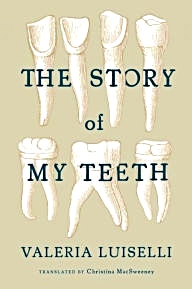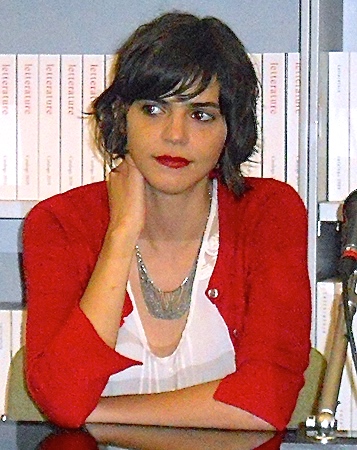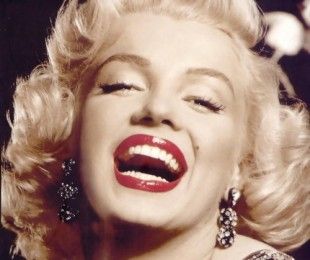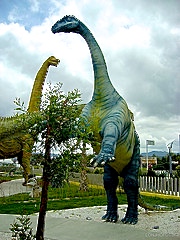NOTE: In 2014 Luiselli was the WINNER of the National Book Foundation “5 under 35” award.
“On a Sunday evening, I went with some colleagues to an auction of contraband memorabilia in a karaoke bar in Little Havana…I had no intention of blowing my check, but, without the least warning, the god of tiny details set paradise before me…Right there, in the depth of the Sunday solitude of a Little Havana auction I found them: my new teeth…the sacred teeth of none other than [Hollywood diva] Marilyn Monroe…slightly yellowed.”—Gustavo Sanchez Sanchez, or “Highway.”
 If that quotation does not pique your curiosity with its absurdity, the succeeding images may. As soon as Highway returns from Cuba to Mexico, he contacts the “best cosmetic dental clinic” in Mexico City and has “each of the teeth belonging to the Venus of the big screen transplanted into [his] mouth,” though he does save ten of his old teeth, the best-looking ones, for later, “just in case.” For months afterward, he walks around Mexico City smiling at his appearance in reflections, celebrating his good luck, and believing that “[his] life was a poem.”
If that quotation does not pique your curiosity with its absurdity, the succeeding images may. As soon as Highway returns from Cuba to Mexico, he contacts the “best cosmetic dental clinic” in Mexico City and has “each of the teeth belonging to the Venus of the big screen transplanted into [his] mouth,” though he does save ten of his old teeth, the best-looking ones, for later, “just in case.” For months afterward, he walks around Mexico City smiling at his appearance in reflections, celebrating his good luck, and believing that “[his] life was a poem.”
Mexican author Valeria Luiselli, an author who has just celebrated her thirty-second birthday, continues this unique story and point of view, expanding the absurdities, incorporating dozens of unique images, story lines, and sudden surprises, and transporting the reader into new and sometimes bizarre worlds. This work, a “novel-essay,” as she calls it, along with all its individual stories, is no pot-boiler, however. It is part of a much more ambitious effort by Luiselli to expand the boundaries of the novel and art in general, and she does this without being the least bit pompous or self-conscious. 
Hired in 2013 to write a catalog for Galeria Jumex, a contemporary art gallery which is associated with the real Jumex juice factory outside Mexico City, Luiselli decided to take a completely new approach to writing the art catalog by including the workers at the factory as she tells stories about the items at the gallery, perhaps creating a bridge between art and the reality of the workers’ own lives within and outside the factory. In an action similar to Cuba’s use of “tobacco readers,” who read stories to the workers in cigar factories to keep them from getting bored, Luiselli chose to write her catalog as a “novel in installments” for the workers, who would then read the installments aloud in the juice factory. Their reactions and comments were recorded and sent to Luiselli, who would then write the next installment, all under the name of Gustavo Sanchez Sanchez, the speaker of this novel.
 As a result of the interaction, some personal stories of the real workers began inevitably to combine with the stories associated with the paintings and other artwork in the gallery, which, of course, has also been taken out of the natural context of a particular artist working in a particular place and time. As the stories from the factory, the artwork, and Luiselli’s own imagination merge, they form a kind of bridge between the rarefied world of contemporary art and literature, and the real world, including the world of the factory workers, some of whom provided photos of the artwork, the gallery, and some of the places near the factory, all of which are reproduced here. Luiselli also explores her relationship with her translator, Christina MacSweeney, who translated Luiselli’s Spanish into English. Luiselli, who is also fluent in English, then reread and rewrote parts of the English version and then made new changes to the Spanish version, eventually inviting MacSweeney to write her own section which appears at the end of the novel and provides unifying information.
As a result of the interaction, some personal stories of the real workers began inevitably to combine with the stories associated with the paintings and other artwork in the gallery, which, of course, has also been taken out of the natural context of a particular artist working in a particular place and time. As the stories from the factory, the artwork, and Luiselli’s own imagination merge, they form a kind of bridge between the rarefied world of contemporary art and literature, and the real world, including the world of the factory workers, some of whom provided photos of the artwork, the gallery, and some of the places near the factory, all of which are reproduced here. Luiselli also explores her relationship with her translator, Christina MacSweeney, who translated Luiselli’s Spanish into English. Luiselli, who is also fluent in English, then reread and rewrote parts of the English version and then made new changes to the Spanish version, eventually inviting MacSweeney to write her own section which appears at the end of the novel and provides unifying information.

When Highway comes to after a disastrous night, he is greeted by the sight of four clowns projected on four walls, with a speaker overhead commenting.
When a very young writer of enormous talent and creativity is given free rein by the art gallery which hired her, the factory which allowed its readers to participate in her work, and her American publisher, Coffee House Press of Minneapolis, the result can only be described as unique – so different from anything any of us have ever had the chance to read or experience (or even imagine) that I, myself, am hoping I will someday see this very young, immensely talented author win a Grand Prize.
Despite Luiselli’s esoteric goals, she also incorporates a wild plot within all this background and explanation, and it is fun and funny and…unique. Gustavo “Highway” Sanchez Sanchez, having begun as a guard in the juice factory, becomes Personnel Crisis Supervisor, a job which keeps him twiddling his thumbs until he is able to take a variety of classes, travel to seminars, and eventually marry the woman who is expecting his child, a baby known as Siddhartha. He later tries to become a contemporary dancer and actor, before he learns that being an auctioneer is a quicker way to success. Having always collected things he that he might sell for profit, he goes to school to become an auctioneer and gets some experience in the US. In Mexico, under the aegis of a local priest, he gets his first chance to practice his new trade – auctioning off his own ten teeth which he saved when he had Marilyn Monroe’s teeth implanted. Believing that he can restore an object’s value “through an elegant surpassing of the truth,” he provides stories as he auctions the teeth, claiming that they belonged to writers such as Plato, St. Augustine, Montaigne, Virginia Woolf, and others. He raises thousands of pesos for his used teeth.

Not far outside the juice factory is a Disneyland-ish display of dinosaurs in action, a location which features in the conclusion.
The book divides into sections which illustrate the several kinds of auctions that Highway has categorized – Hyperbolics, Parabolics, Circulars, Allegorics, and Elliptics – and expands the story as the reader learns about the reappearance of Highway’s son Siddhartha, who is bent on revenge for his father’s abandonment of him and his mother. Throughout all this, the author maintains a fine literary style with many references to literature’s greatest and their works; a sensitivity to sound and spelling, which she uses for puns (and characters like Hochimin and a barbershop called Hair Charisma); and a knowledge of art, both contemporary and classical. (At one point, for example, Highway refers to “the crescent of my [new] teeth…sacred, graceful, and hallowed as Bernini’s St. Peter’s Colonnade.”) Though the novel is a free-for-all in terms of the speed of the imagery and the shifts in focus, it is well organized without being limited. Luiselli’s experiment pays off handsomely here as she shares her stories and involves her audience in creating them, and her imagination and intelligence make them a delight for readers. For those readers who may wonder where a form like the novel can go next and how much it can change without losing its way, Valeria Luiselli’s latest effort shows one way.
ALSO reviewed here: FACES IN THE CROWD and LOST CHILDREN ARCHIVE
Photos, in order: The author’s photo appears on http://sextopiso.mx/
Marilyn Monroe’s Hollywood smile is shown on https://www.pinterest.com/
The clowns that greet Highway when he wakes up from a bad night are from http://www.fanpop.com
The dinosaur park, outside of Pachuco, may be seen here: http://flickrhivemind.net
ARC: Coffee House Press
